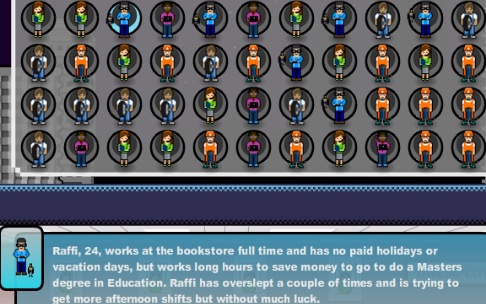The past few weeks in Washington DC have been incredibly surreal. Hell, the past few months have been pretty odd. The two topics I hear about most in my daily social circles, apart from our immediate task needs, are videogames and politics. And with the way that gamesmanship pervades the political realm, I can’t help but see them in mixed terms. First, it was the hordes of political activists campaigning for their candidate. Then Fallout 3 started promoting in the Metro, and the game forever changed my mental map of the DC Metro area. And then the election and subsequent inauguration — both of which created real, palpable chaos on the streets. Fear! Uncertainty! Disbelief!
And then, calm. A feeling of relief has swept into the city, and I can visibly notice an upswing in mood that is not the mania of the inauguration, but is certainly is elevated. The dog days of the Bush administration are over, and the future is much brighter than it has been in a long time.
But it is still unclear exactly what the new administration means for videogame legislation. We have gotten few glimpses of what Obama brings to the discussion, and the Democrats have a rocky past with the subject of videogames and freedoms of speech in general.
Historically, the Democrats have not done well with videogames. Democratic Senators Hillary Rodham-Clinton and Joe Lieberman co-sponsored the Family Entertainment Protection Act (FEPA) in 2005. This bill would have mandated government oversight of ESRB ratings, a whole secret-shopper program to catch noncompliant retailers, and stiff penalties for selling adult rated games to minors. Had FEPA passed, it would have cost the government a bundle of cash every year and would have also set a disturbing precedent. Keep in mind that at this point both the MPAA (the movie ratings board) and the ESRB (the game ratings board) are private organizations whose power comes from an agreement worked out by members of the respective inudstry. Government censors need not be involved.
Obama does not curently seem to be interested in focusing on censorship over more pressing issues, such as our economic collapse and multiple wars. However, as GamePolitics tracked throughout the primary and election process, Obama does clearly connect videogames to underachievement:
You know, I will invest in education. We’ll make sure government gets behind the schools. But it won’t make much of a difference if parents aren’t turning off the television set and putting away the video games and making sure that our children are doing their homework.
In light of the recent push for educational videogames, and building research confirming that games are educational in a variety of ways, I’d much rather hear Obama talking about creating more ways to reach students and seizing the power of all our media options to connect with learners. With games like Operation: Resilient Planet and the current wave of “pop-ed” games for Nintendo DS and other more casual platforms, the world of educational gaming is just beginning to come to life. I hope that the Obama administration will actually tend more towards the other side they’ve shown.
Never before has a presidential campaign or administration embraced technologies of communication so enthusiastically. From SMS text messaging to video blogs, the Obama administration has done a great job leveraging the power of technology. Their social web experiments have garnered a lot of positive attention and they have left no tone unturned when exploiting the power of networked communications to further their message.
They even advertised prominently during the election in videogames. Their ads showed up in a bunch of titles on Xbox Live. Millions of gamers saw Obama’s smiling mug while racing at breakneck speeds or strategizing dominance on the field. These advertisements were clearly successful and contributed to the building of Obama’s cool cred. Xbox Live also featured special coverage of the Inauguration as free video downloads.
It would be very unfortunate if these sorts of enthusiastic and strategic uses of technology were limited to increasing Obama’s political cache. We need the same kind of informed, innovative and effective use of technology in our classrooms and government operating procedure. And videogames have always been connected to innovation and adoption of technology. Games provide a lot more than the momentary respite from the day to day grind, or the proverbial “five minutes of fun” that so many markerters and apologists claim.
At this moment, another example of a hysterical political response to something lawmakers clearly do not understand is making its way through the New York State Assembly. Assemblyman Brian Kolb (Republican) has introduced a law that would require a whole lot of crazy things from NY retailers and game makers. At first blush, the requirement for game makers to provide a free demo of every game sounds like good business. But requirements for retailers to keep mature content games in a locked cabinet and for the state to impose its own ratings system sound, again, like expensive and pointless nonsense. The real comedy gold of the bill is in the required warning label mandated by the bill:
WARNING, SALE OR RENTAL TO ADULTS ONLY. MAY CONTAIN EXPLICIT DEPICTIONS DESCRIPTIVE OF OR ADVOCATING ONE OR MORE OF THE FOLLOWING:
- COMMISSION OF A VIOLENT CRIME
- SUICIDE
- SODOMY
- RAPE
- INCEST
- BESTIALITY
- VIOLENT RACISM
- RELIGIOUS VIOLENCE
- SADO-MASOCHISM
- SEXUAL ASSAULT
- SEXUAL ACTIVITY
- MURDER
- MORBID VIOLENCE
- ILLEGAL USE OF DRUGS OR ALCOHOL
The bill requires that if a game contains any one of these items it must contain the whole list on the back of the game. While we regularly see games with violent crimes, references to alcohol, and possibly even murder or morbid violence, I have never played a game involving sodomy, rape, incest, or bestiality. Even more to the point is that a general list like this is never going to be as effective as a list based on the actual content of a specific game, such as the list that already exists on every game reviewed by the ESRB.
This is just one example. There are many similar pieces of legislation in the US and abroad, illustrating just how much of a struggle it has been for mainstream society to deal with videogames. However, the pervasiveness of games increases, and all the lawmaking in the world has yet to stem the tide of games. With more powerful tools for individuals to participate in high quality game making on the rise, it is unlikely that the medium of videogames will be truly stymied in the near future. It is an eleven billion dollar industry that no country wants to lose.
Yet what lawmakers do can have a great impact on the games we see developed and the progress we make in leveraging the technology for the benefit of the culture. As White House staffer Bill Burton said, for the Obama team coming into the building was like going from “an Xbox to an Atari”. That reflects well the lack of progress the Bush administration did in effectively leveraging any kindof modern human knowledge. And hopefully it also reflects a bit more of the savvy of the new administration.
But we are gamers, and gamers always want more. We want an Xbox 360.
 Revisiting some favorite themes, Episode 023 also sees us joined by J Goldberg, Community Manager at Volition. Having recently shipped Red Faction: Guerrilla, J sits down with us for a conversation on open world gaming and the significance of destructible environments (metaphorically as well as mechanically). We also take on fears of simulation and representation, shifting similarities between games and other artistic spaces, and player characters in fictional roles and their importance. Thanks to J, don’t forget about our book club, and enjoy.
Revisiting some favorite themes, Episode 023 also sees us joined by J Goldberg, Community Manager at Volition. Having recently shipped Red Faction: Guerrilla, J sits down with us for a conversation on open world gaming and the significance of destructible environments (metaphorically as well as mechanically). We also take on fears of simulation and representation, shifting similarities between games and other artistic spaces, and player characters in fictional roles and their importance. Thanks to J, don’t forget about our book club, and enjoy.



Alexander has been posting and tweeting all week from the Electronic Entertainment Expo in Los Angeles. Among her impressive amount of info-relay is this column up over at GameSetWatch, in which she makes the argument that Electronic Arts’ upcoming video game Dante’s Inferno need not worry about trying too hard to adhere to its literary namesake. In describing the game as an “action title set in Hell,” Alexander asks a certainly appropriate rhetorical question: “Why not have fun with it?”
Fun is almost always the baseline value by which we evaluate something we might call a “video game” (tangentially: if you want to get really semantic about this term, check out the latest episode of Big Red Potion, where Sinan Kubba, Joseph DeLia, Eddie Inzauto and yours truly get into some interesting territory about what we might mean or assume when we use that particular word). By nature, we are creatures who prefer the warm fuzzy over the cold prickly, and activities which require us to focus for long stretches of time and draw more than summary conclusions about what we’ve experienced are made more difficult when we aren’t having a pleasant time doing them.
Games and fun might go well together like chocolate and peanut butter, but let’s be careful not to assume that these aren’t incredibly subjective things we’re talking about. And yes, I know all of this nit-pickery about terminology can get incredibly tedious and annoying, but these acts of definition are nevertheless important, because when we talk about games as a medium, we are essentially talking about how game designers communicate ideas through building artistic vehicles for those ideas, as well as how game players receive and react to those ideas. When we whittle these efforts down to whether a game is “fun” or not, a lot can get lost in the trimming.
Case in point: Dante’s Inferno. Alexander writes, “The Divine Comedy, after all, is largely a poem about two guys walking and talking, not exactly the core gameplay of an action game. In that way, the liberties the [design] team took were intended to create a stronger video game, a more reasonable priority for, well, a video game, than focusing on a strong epic poem adaptation.”
These “liberties,” Alexander reports, include depicting Dante as “a former Crusader armed with a giant scythe that looks like it’s made out of a monster’s spine,” who embarks upon “a vaguely risque subplot about rescuing Beatrice from the devil’s seduction.” Some of the obstacles blocking this digital Dante’s path include “the imagination of Chiron’s [sic] boat as a living entity with a head to be twisted off at the neck,” and “unbaptized babies running around with weapons.”
“Gleefully gruesome and literally hellish,” Alexander continues, “the game seems to use the poem’s backbone and references to enrich an action game, rather than use the game as an attempt to emulate an epic poem in video game form…Audiences would like a game that uses the medium’s potential to correspond with other cultural sources, and that’s an excellent goal.” She punctuates her astute observation in asserting, “Dante’s Inferno is not that game — it would rather be an action title. And that’s okay.”
I am lockstep with Alexander in seeking out connections video games have to other artforms. I, too, believe that finding the places where these media (“sources”) intersect (“correspond”) is worthwhile. For me, whether a game is “fun” or not is almost always secondary to me deciphering what it might be trying to tell me, and then deciding what I ultimately think about that particular argument, issue, or aesthetic. How “successful” a game is has everything to do with its coherence as an artistic expression and nothing to do with its NDP numbers. For me, games are an interactive conduit for ideas, arguments and meaning, and “action” is that thought, deed or utterance inspired by the experience of playing the game.
So what’s the problem, then? It’s simple: caught up in the never-ending cattle rush among other videogame publishers to acquire and trademark new brands of intellectual property, Electronic Arts have marginalized Dante Alighieri’s Commedia as little more than a crudely-painted backdrop for a yet another insipid action adventure. And as much as I respect Leigh Alexander, I’m not at all sold on the And It’s Okay argument.
Since Electronic Arts’ attention span for Dante’s Commedia begins and ends with Inferno (dare we imagine what its take on Paradise might look like?), it’s important to consider the “recognizable symbology and references” from that particular section of the epic that so-called “literature buffs…[will] still get a kick out of.” More precisely, it’s important to consider those references in their proper contexts. This assumes that we are indeed sincere about finding those places where different “cultural sources” do that “correspond” thing they do; of course, part of the problem is we already know that old colloquialism about what an assumption makes out of you and me.
See, here’s the rub: to even begin approximating the underpinnings of Alighieri’s 14th century text-based adventure, Dante’s Inferno’s executive producer Jonathan Knight would need to conceive and deliver anti-papist imagery so graphic and severe that Dan Brown’s conspiracy theory novels would truly pale in comparison. But this assumes (there’s that word again…) Knight and his development team at Visceral Games (1) understand Alighieri’s justifications for all the savagery depicted in Inferno and (2) actually care about pulling them all the way into the 21st century; on both counts, this could be assuming far too much.
I submit for your consideration this recent interview with EuroGamer’s Kieron Gillen, in which Knight explains:
That he would supplement the “literary experience” (meaning…???) “with fighting” demonstrates a fundamental misunderstanding about Dante Alighieri’s agenda as a game designer. His Commedia—and especially the 33 cantos he called Inferno—is pure agon. It is The Fight itself, given body and force through text. If there is fantasy in Dante’s epic, it is very much a fantasy of the real; if there is insanity, it is only so due to patience and lucidity.
Because here’s the heart of the matter: Electronic Arts would no more have us butcher Boniface than miss their annual Madden ship date. The National Broadcasting Company still has never rebroadcast arguably the most incendiary 9 seconds of live television ever shown in the United States, wherein after performing an a capella rendition of Bob Marley’s “War,” singer Sinead O’Connor tore up a picture of Pope John Paul II and urged everyone watching to “Fight the real enemy.”
httpv://www.youtube.com/watch?v=iYw8JR1N90o
If you thought the Catholic League came unhinged over Kevin Smith’s Dogma, just imagine their reaction to a video game wherein the player-interactor willfullly exacts corporal punishment upon a pope.